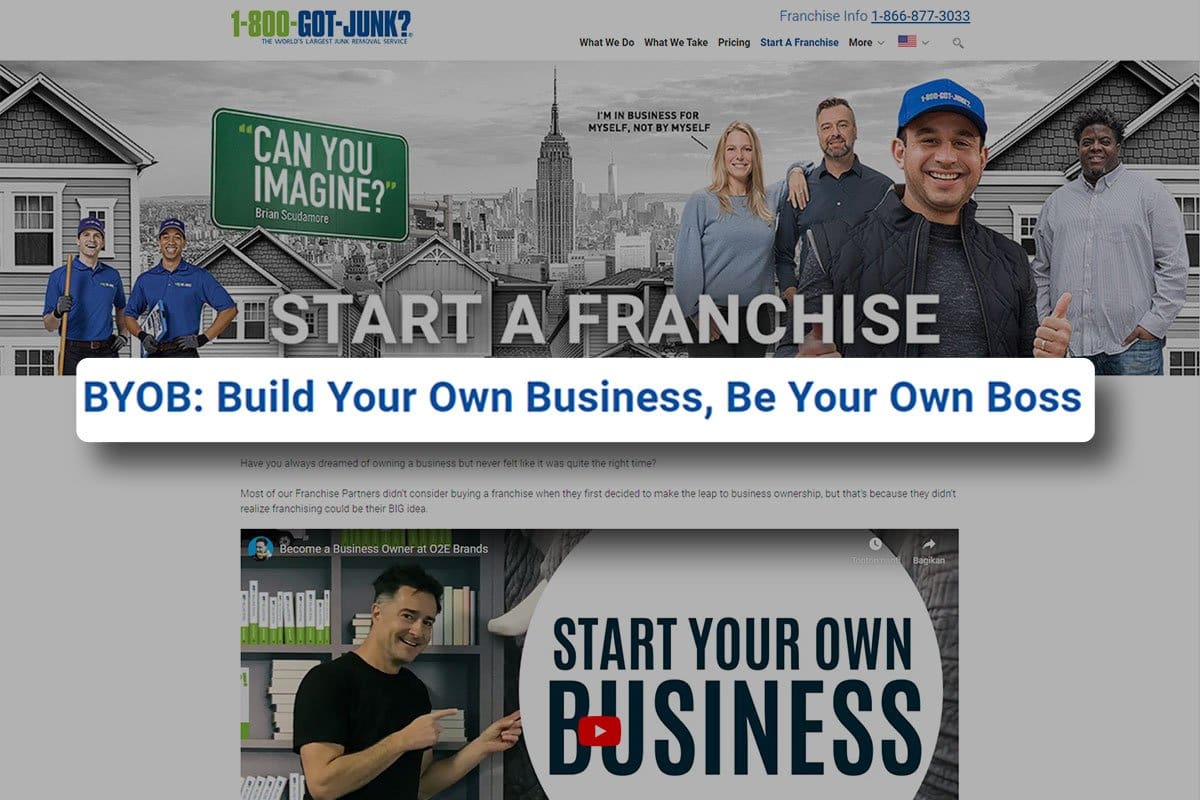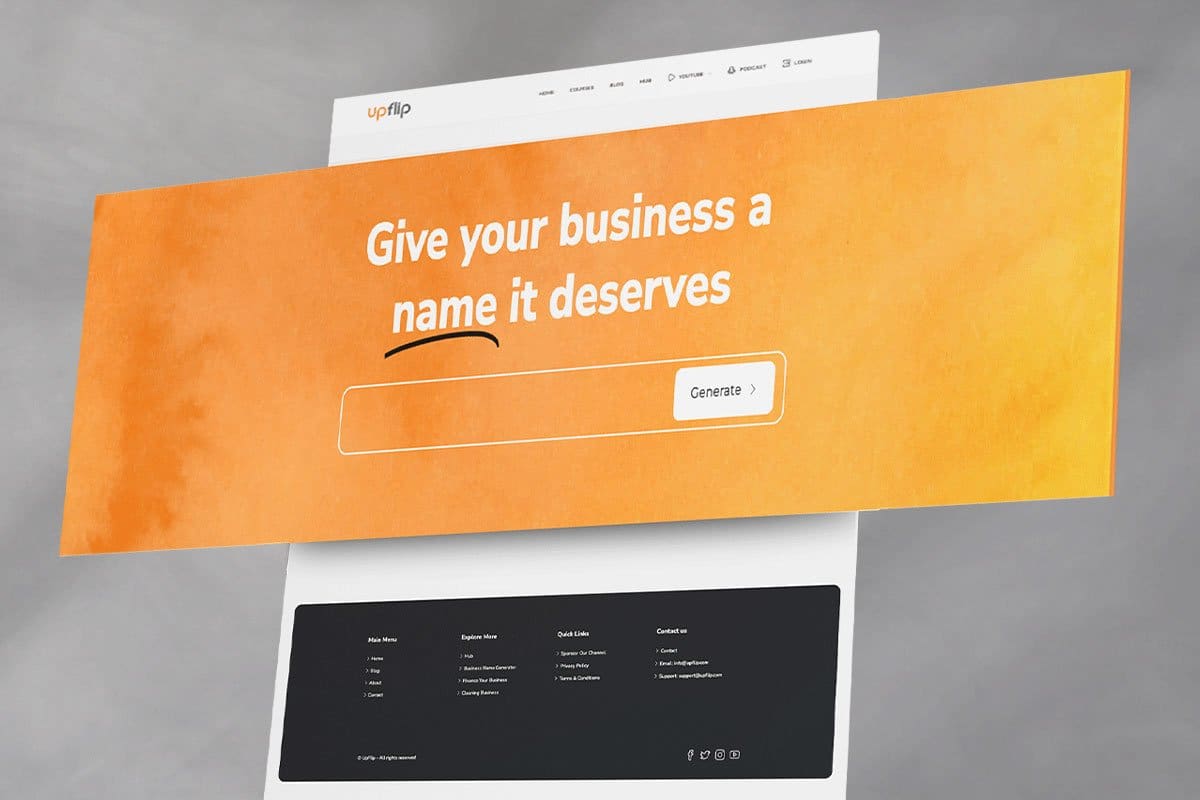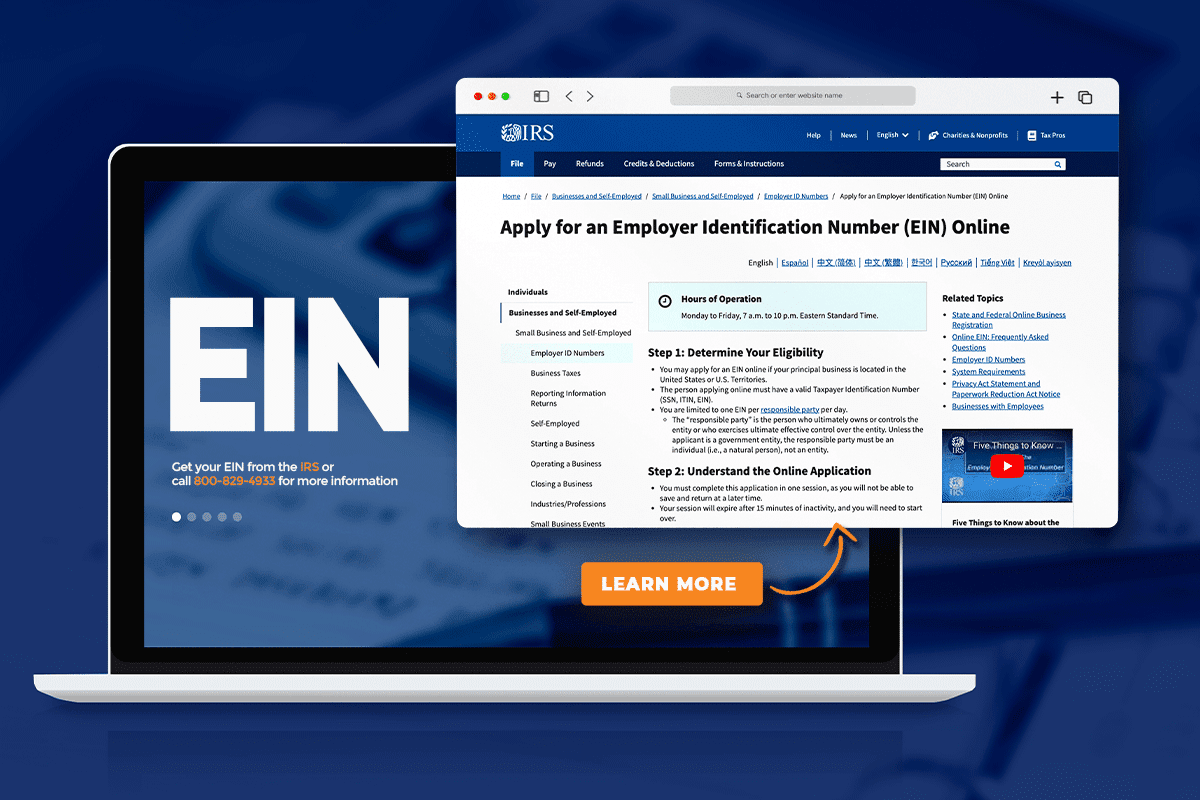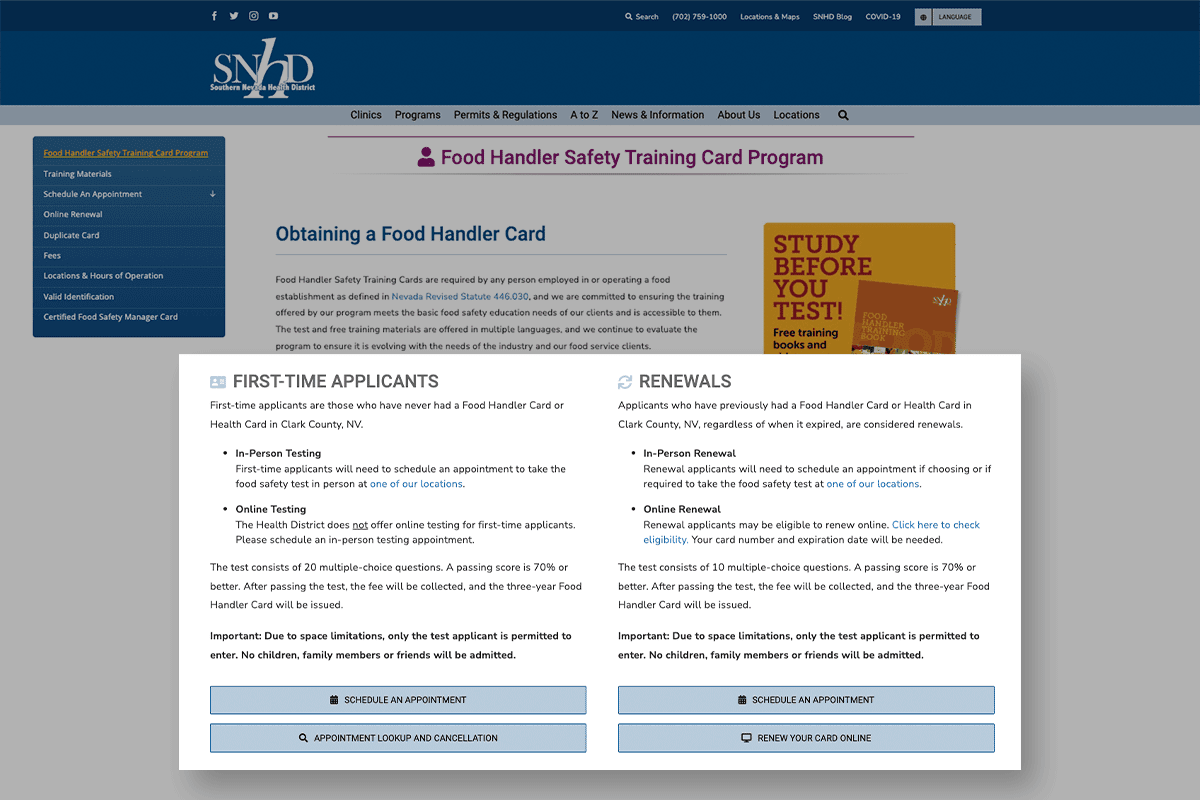340 Best Food Truck Names
February 26, 2024
February 26, 2024

Did you know there are nearly 50K food trucks in the U.S.?
From Asian street food to burgers, sweet treats, and pizza, there’s a food truck for everything. So for those who want to open a food truck, unique food truck names help them stand out from the pack.
We’ll share what makes a good food truck business name, provide lots of food truck name ideas, and show you how to register your food truck name after you choose one.

When choosing a name for your food truck business, there are a few things you’ll want to keep in mind:
With that in mind, take a look at the following food truck names. Consider them food for thought.
Consider the following list to name your own food truck business.
1. Culinary Voyage
2. Roving Refreshments
3. Fry Hard
4. Cookin’ & Cruisin’
5. Motor Munches
6. Gourmet Odyssey
7. Grill Seekers
8. Chow Down
9. Parked Pita
10. World Plate
11. Brownie Points
12. Smoothie Operator
13. The Juice Box
14. Latte Da
15. Lemon Aid
16. Pop Up
17. Seoul Food Seduction
18. Nomadic Noodles
19. The Journeyman’s Feast
20. Burnout Burgers
21. Fastlane Food Co.
22. License to Grill
23. Curbside Cookin’
24. Stove on the Street
Pro Tip: Describe what your food truck serves in your business name. This will help people find you when they’re searching online. Many of the food truck name ideas in this list focus on common searches.

Some of the funniest food truck names are ones that are a play on words. Consider some of these fun food truck names:
1. The Codfather
2. Lord of the Fries
3. It’s Hot in Here
4. Wok & Roll
5. Wok & Stroll
6. Bun Voyage
7. Nacho Average Truck
8. Curry On
9. Buns N’ Roses
10. Pho Sho
11. Pasta La Vista
12. The Grillenium Falcon
13. Frying Nemo
14. Crepe Expectations
15. Muffin Top
16. Donut Worry
17. Pizza My Heart
18. Pho-verload
19. The Souper Hero
20. Seoul Mates
21. Forking Awesome Food Truck
22. Gas Money Grill
23. The Flat Tire
24. Haulin’ Oats
Other food trucks will have difficulty competing with these clever food truck business name ideas.
1. Drury Lane Muffin Co.
2. The Wandering Wok
3. Wanderlust Wok
4. Bun & Run Burgers
5. Whisk World Cuisine
6. Sushi Shuffle
7. Bite-Sized Bliss
8. Ramen Renegades
9. Seoul Searching Korean Delights
10. Global Grubbin’
11. Cheesus Crust
12. Dumpling Dynasty
13. Truck Yeah!
14. Spice & Dice: World on a Plate
15. Sushi Seishin
16. Soupercalifragilisticexpialidocious
17. Curry in a Hurry
18. Muffin to Lose
Pro tip: Don’t be afraid to be creative and original with your food truck names. Funny business tames tend to help make your food truck stand out.
Good names for food trucks are abundant. Consider some of these names for your truck.
1. Falafel Freakout
2. Fork Yeah It’s Flavorful
3. Spice & Dice Dice Baby
4. Burly Burgers & Beyond
5. Naan-believable Flavors
6. Forking Awesome Food Truck
7. The Wandering Wok Warrior
8. Sushi Shuffle
9. Bite-Sized Bliss
10. Queso-lution
11. Curry Up & Eat
12. The Bao Bunch
13. The Wandering Grill
14. Spice Up Your Life
15. The Wandering Pizzaiolo
16. Bite Squad
17. Dumpling Dynasty
18. Spice & Dice
19. Food Truck Follies
20. Where East Meets West
Pro Tip: Once you have a few food truck name ideas, test them out on your friends, family, and potential customers. Get their feedback and see what they think is the perfect food truck name.

Let’s taco bout some taco truck names. Whether you prefer a crunchy taco, soft taco, or enchilada, you need a great name for when you sell out of a taco trailer or truck. Check out some of these ideas.
1. El Guacahólico
2. Taco ‘Bout Delicious
3. Taco ‘Bout a Fiesta
4. Island Hoppin’ Habanero
5. The Cheesy Grinner
6. Aloha Avocado
7. Taco the Town
8. Mac Daddy Machaca
9. Baja Fiesta
10. Taco Loco
11. Mole Mole Mole!
12. Condor Carnitas
13. Taco Fuego
14. The Black Bean
15. Taco Twist
16. Machaca Madness
17. Tofu Tango
18. Taco Samurai
19. Kickstart Fiesta
20. Taco Hero
21. Tacos on Wheels
22. Taco Space
Looking for a juicy name for your food truck? Try some of these food truck name ideas.
1. Spice It Up & Go!
2. The Hungry Hippie
3. Bite Me Burger Company
4. The Wandering Waffle Shop
5. Sizzle & Chill Grill
6. Pho Real, Folks! Food Truck
7. The Rolling Ravioli Company
8. Spice & Dice Cuisine
9. Wok This Way
10. Fork Yeah! Food Truck
11. The Burger Brigade
12. Pizza My Heart Truck
13. Dumpling Dynasty
14. Bao Buns & Beyond
15. Falafel Frenzy Food Truck
16. Curry Up, Sunshine!
17. Wok ‘n’ Wander Eats
18. Fork in the Road
19. Sizzle & Spice Streetside Cuisine
20. The Wandering Whisk
21. The Burger Brigade
22. Streetside Sensations
Pro Tip: Once you’ve chosen a food truck’s name, you need to protect it. Make sure to register it with the appropriate government agencies. This will protect your name from being used by other businesses.
1. Burrito Bae
2. Guac and Roll
3. Salsa and Spice
4. Fajita Fiesta Company
5. Elote of Love
6. Tamale Time
7. Enchilada Express
8. Cilantro and Lime Shop
9. Tortilla Thrills
10. Mexi-Go
11. Flan-tastic
12. Empanada Emporium
13. Margarita Madness
14. Nacho Mama’s Truck
15. Quesadilla Queen Shop
16. Burrito Bandito Company
17. Tostada Truck
18. Salsa Verde Shop
19. El Nopal Truck
20. Mexi-Melt Company
21. The Parked Piñata
22. El Diablo Truck
Pro Tip: This list is just the start. Your food truck name could even be in Spanish—just make sure it’s clear to all customers what you’re offering.

1. Rocky Road Trip
2. Cone with the Wind
3. Scoop Dreams
4. The Ice Cream Team
5. Sundae Funday
6. Chilly Vanilly
7. Frozen Assets
8. Lickety Split
9. The Cone Zone
10. Ice Ice Baby
11. The Chill Grill
12. Cream of the Crop
13. The Dairy Godmother
14. The Scoop Troop
15. Cone Appetit
16. Freeze the Day
17. The Sweet Spot
18. Frosty Bites
19. The Cream Machine
20. The Cone Ranger
21. The Iceberg
22. The Big Chill
23. The Frosty Fox
24. The Whipper Snapper
25. The Cold Case
26. The Ice Breaker
27. The Sugar Rush
28. The Frost Bite
29. The Ice Cap
30. The Sherbet Shop
31. The Cream Dream
32. The Slush Puppy
33. The Cone Head
34. The Ice Palace
35. The Scoop of the Century
36. The Chill Factor
37. The Cone-ucopia
38. The Ice Cream Station
1. Bite Co.
2. Bun Appetit Shop
3. Sauceome Company
4. Cheese Louise Co.
5. Bake It Easy
6. Brew Ha Ha
7. Souper Star
8. Pizza My Heart Co.
9. Rice and Shine
10. Chili Out
11. Muffin to Lose Co.
12. Falafel in Love
13. Wrap Star Shop
14. Fork It Over LLC
15. Pancake Break
16. Bread Zeppelin
17. Croissant Moon Co.
18. Noodle Around
Pro Tip: Food trucks normally cost between one-sixteenth and one-third of what it costs to start a restaurant. That makes a food truck a great way to become a food entrepreneur.
1. The Fry Guys
2. Wok This Way
3. Taco ‘Bout It
4. Curbside Bites
5. Fries Before Guys
6. The Rolling Scones
7. Pita Pan
8. Souper Heroes
9. Buns on the Run
10. The Cheesy Rider
11. The Meatballer
12. The Spice Girls
13. The Crust Crusader
14. The Wrap Pack
15. The Crepe Escape
16. The Pie Hole
17. The Salad Bar
18. The Mac Attack
19. The Hummus Among Us
20. The Gyro Hero
21. The Rice Guys
22. The Pizza Cutter
23. Kebab King
24. The Noodle Bowl
25. The Sushi Bus
26. The Cookie Monster
27. The Pancake Stack
28. The Muffin Man
29. The Cupcake Factory
30. The Candy Crush
31. The Chocolate Bar
32. The Sweet Tooth

1. Crave Crafts
2. Flavor Wagon
3. Taste Trip
4. Yum Rush Express
5. Munch Master
6. Flavor Frenzy
7. Naan of Your Business
8. GourmetGo
9. Chow Chaser
10. Meatballin’
11. Kebabylon
12. Chili Con Carnage
13. The Breakfast Club
14. Banh Mi and You
15. Rice Rice Baby
16. Hot Dogma
17. Pie Hard
18. The Falafel Tower
19. The Hummuside
20. Nacho Problem
21. Sushi and the Banshees
22. Bacon and Legs
23. The Spud Stud
24. The Wingman
25. The Ramen Empire
26. Gyro Hero
27. The Sandwich Witch
28. The Pasta Point
29. The Burrito Bandito
30. The Donut Hole
31. The Pancake Stack
32. The Bagel Boss
Pro Tip: If you can’t think of a show stopping name, the simpler the better. Let potential customers know what to expect.
1. Wok n’ Stroll
2. Cheesy Does It
3. Forklore Fusion
4. Patty Paradise
5. Taco ‘Bout Tasty
6. The Crepe Escapee
7. Poke a Hole in Hunger
8. Quesadilla Craze
9. Grillin’ & Chillin’
10. Wafflicious Treats
11. Gyro Giro Gyro
12. Bao Down Bliss
13. Arepa Allure
14. Ramen Rhapsody
15. Pizza My Slice
16. Wrap It Real Good
17. Smoothie Showdown
18. Donut Delight
19. Burrito Bonanza
20. Noodle Nirvana
21. Curry Up Already!
22. Wok with Wisdom
23. Naan-stop Munching
24. The Patty Playground
25. Wok a Wonder
26. Arepa Aficionado
27. The Ramen Renegade
28. Gyro-matic Flavors
29. Wok Wonders
30. Bun Bonanza
31. Cheesy Dreamland
32. Forklore Fantasia
33. Batter Blastoff
34. The Sandwich Stand

1. Batter Believe It
2. Flippin’ Awesome
3. Breakfast of Champions
4. Caffeinated Caravan
5. Bacon Me Smile
6. Oattitude Adjustment
7. Morning Mantra
8. Sunny Smoothie Stand
9. Sunrise Sippers & Snacks
10. Burrito Sunrise
11. Bagelicious
12. Fritter Fanatics
13. Flapjack Fiesta
14. Scrambled
15. Muffin Monarchy
16. French Toast Frenzy
17. Sconehenge
18. Sunrise Snacks & Sips
19. Griddle Galaxy
20. Yolked & Loaded Express
21. Pancake Playground
22. Caffeinated Creations
23. Donut Disruption
24. Croissant Conquest
25. Scrambled Sunshine
26. Rise & Shine Smoothies
27. Muffin Menagerie
28. French Toast Fairytale
29. Donut Delights & Dreams
30. Smoothie Shack Sensation
31. Oatventure Awaits
32. Scrambled Sensations
33. Donut Den
34. Croissant Crusaders
You’ll have to go through some extra steps to register your food truck’s name because food establishments commonly need health inspections. This goes for a brick-and-mortar restaurant, too.
We’ve talked with a lot of food truck business owners about how to get started in the food truck industry. Check out some of our other resources for food truck owners:
You finished the naming process, but there is still plenty of work to do in your culinary adventure. Start by checking out our step-by-step guide on how to start a small business.
Brandon Boushy
Do you like physical work and driving around? Maybe starting a junk removal business is right for you.
Kyle Landwehr started Slam Dunkin Junk and The Junk Academy three years ago. Now he’s making $200K to $300K every month to haul away junk—and teach people how to start a junk removal business of their own.
[su_note note_color="#dbeafc"] With advice from Kyle, we’ll answer the questions about starting a junk removal business below. Click on any link to learn more, or just continue reading.

A junk removal business focuses on removing unwanted furniture, appliances, and other items from residences and businesses. It also includes garbage collection, and you may hear it referred to as the waste removal industry.
It’s physical work, and it’s possible to injure yourself. Kyle shared:
[su_quote]I was making $30K to $40K monthly when I broke my ankle stepping off the truck. Breaking my foot is what caused me to start hiring employees and [scale] my business to what it is now.[/su_quote]
He also explained that his injury got him into real estate. Listen to the interview below to find out how:
You should understand the junk removal industry before you enter it. Some of the important questions you should ask before you start a junk removal company include:
The amount of money you need to start a junk removal business will depend on the business’s location (due to cost of living) and the materials you already own.
The items you’ll need to start a junk removal business include:
• A truck: $1,000 to $90,000
• Limited liability company (LLC): Under $1,000
• Business license: Under $1,000
• Business insurance: $1,000 to $10,000
• Dolly: $200
• Trash bags: $25
• Reciprocating saw: $300
• Safety equipment: $100
• Website: $1,200 per year
That means you can start a junk removal business for as little as $4,325 or as much as $102,325. Kyle told us:
[su_quote]If you have a truck, expect to spend around $6,000 starting your business. If you want to know how to start a junk removal business with no money, promote it on Facebook groups during the week and rent a U-Haul on the weekend. That will cost you $40 per day, plus $1.30 per mile.[/su_quote]
According to IBISWorld, there are 8,607 companies in the junk removal industry. They make a combined $73.7B, or $8.6M each. Kyle told us he makes $200K to $300K a month as a junk removal company owner.
Yes. The gross profit margin is 32.74%, while the junk removal profit margins come out to 7.29% after after taxes, bonuses, and all other costs. This is based on data from 62 publicly held companies.
Kyle told us:
[su_quote]The gross profit margin the first year was around 50% margin, [the] following year 30% to 35% margin, and the third year I hired an operations manager, which took the margin down to 20%, but now I don’t have to be involved in the business.[/su_quote]
The salary for working as an operations manager is around $75,000 annually for waste removal companies. This is nearly $18,000 less than other operations managers. When you run an S-Corp, you will need to use that as your wages and any profit you can pay as dividends.

For your company to be a profitable business, make sure to write a business plan.
You’ll want to include:
Check out our interview with Mike Andes to learn how to write a business plan. You can refer to our business plan writing guide as well.
Kyle told us:
[su_quote]My smartest business move was building my plan.[/su_quote]
A distinctive and memorable brand for your service-based business sets you apart from competitors and establishes a reputation for your enterprise. Your brand relies on two main elements: your business name and logo.
First, select a junk removal business name that draws in customers and conveys a strong message about your services. Make sure it’s not already taken in your service area and online.
Next, craft a logo for your junk removal service. You have the option to hire a designer for assistance, or you can create one yourself using an online logo creator such as Canva.
You’ll want to register your business with your state. Kyle and most other business owners recommend structuring your business as an LLC, but there are plenty of other structures. Learn more about the business registration requirements and process in our business registration guide.
The cost of registering on the Secretary of State website varies from state to state. To give you an idea of the cost, Kyle said he paid $300 for his LLC in St. Louis.
You’ll also need an Employer Identification Number from the IRS.
A junk removal business may need local or county licenses. Check with your local government’s business office to see what is required in your state.

You may need special licenses and permits for waste removal if you collect hazardous waste or do construction tasks like demolition (which Kyle offers in addition to junk removal services). He also told us:
[su_quote]You could also offer dumpsters for people [which requires licenses].[/su_quote]
Your local business office will be able to help you establish what business licenses you need.
A junk removal business needs a small business bank account before it offers junk removal services. The business bank account should have low fees and high interest rates on savings accounts. Keeping your finances separate will be helpful when tax season arrives.
You’ll also need junk removal business insurance. A junk removal company will need commercial auto insurance and general liability insurance at a minimum, but you might want more extensive business insurance, like a business owner's policy (BOP). Learn more in our business insurance guide.
A BOP covers general liability, property damage, and unexpected shutdowns, plus has riders for other policies. We suggest contacting Simply Business to get quotes from multiple insurance companies.
For added financial management, consider enlisting the services of a bookkeeper or accountant. They can oversee business income and expenditures, handle bills and payroll, generate and dispatch invoices, and maintain the financial health of your business.
Getting paid for removing junk is nice, but junk removal business owners need to make a profit. That means you need to cover your labor, materials, and overhead costs. To achieve this, it's essential to develop a pricing strategy for your waste removal business:
Once you've established your junk removal business pricing, you’ll want to create a junk removal price sheet.

Junk removal businesses need a variety of tools, equipment, and software to run successfully.
We’ve got you covered! Get all the supplies you need as a junk removal business owner from the UpFlip Junk Removal Store, or check out the list of tools you need for junk removal jobs below.
Junk removal businesses need the following:
Author’s Note: Hauling away a ton (2,000 pounds) of air conditioners can make you around $2,000, based on my time working in HVAC.
You might want other tools including:
Next, find out how to market your junk disposal company.
When you start a junk removal business, you’ll need to build a name for yourself. To market yourself, you should:
Social media is a powerhouse for all forms of service businesses. Kyle told us:
[su_quote]I went all in on social media, specifically Facebook. You used to have to go to businesses to network, but I can get way more leads from social.[/su_quote]
Junk removal businesses should:
Kyle also explained that Instagram is better for marketing his junk removal coaching business.
You’ll need to find customers who need junk disposal services. There are a lot of ways to help people find you when they need help. Kyle discussed where you can find potential customers:
[su_quote]Social media, Google (both search and local ads), flyers, door knocking, and Yelp are all good places to find leads.[/su_quote]
Business software is necessary to help potential customers find your business and manage all the jobs.
The main requirements you are looking for in software include a website, email and text automation, quotes, invoicing, and a customer relationship management system.
Many junk removal businesses use either Jobber or Housecall Pro, which offer all of the services above. Based on testing both for blogs, I like Housecall Pro’s functionality better.
Quote prices
Once you have gotten leads, Kyle said that you’ll want to go to the person’s residence or business location so you can see the extent of the junk haul-off. There, you’ll examine what you need to remove and provide an estimate. If you’re in the junk removal truck, you might even be able to haul the junk immediately.
You should also provide a business card so they can contact you if they don’t want the junk removed immediately.
In addition to offering home and office junk removal, Kyle suggested the following services:
[su_quote]You can also offer house flipping, dumpster rentals, and demolition.[/su_quote]

When it’s time to collect the junk, you’ll go to the customer’s location and put it in the truck or scrap trailer. Removal time will depend on the number of items, ease of getting to them, and other tasks you need to do.
When you are done, you’ll want to get paid for junk removal. You might also want to provide junk removal business cards because the waste removal industry doesn’t get much repeat business, but business cards could help you get referrals.
Finally, you’ll take the junk to the dump, a recycling yard, or somewhere that you can repair it. When there are things you can recycle or repair, you can commonly make some extra money when you have slow periods.
When you start a junk removal company, you’ll want to find ways to expand it. Kyle told us:
[su_quote]Focus on perfecting one thing, but be open to expanding to other services. In my case, it led to house flipping and coaching.[/su_quote]
You could recycle or repair appliances to make extra money, too. As your business grows, you could also franchise your business to help other people get started quicker.
Kyle explained:
[su_quote]Lots of people thought I was all talk, but once I started a lot of my friends wanted to become junk removers.[/su_quote]
If you don’t want to work with friends, learn about hiring employees from a recruiter.
Establishing and documenting systems and policies for your business can make it run smoother, even in your absence.
Junk removal pros normally charge a minimum pickup fee of $50 to $150, and larger jobs may cost a minimum of $100 to $450. If customers rent dumpsters, those may cost $30 to $285 per day.

Yes, you can buy a junk removal franchise. Some of the common junk removal franchises are:
Learn about other junk collector franchises.
Whether you want to start a junk removal side hustle, buy a franchise, or start your own business, we’ve covered every aspect of entering the junk removal business as an entrepreneur.
It’s up to you to get started. What kind of junk removal will you do?
 According to IBIS World, the food service industry makes over $1.12 trillion across over 1 million businesses. There are 135 reports that come up covering restaurants from pizza places to italian, franchise, fast food, or single-location full-service restaurants.
For the purpose of this article, we’ll use report 72211b: Single Location Full-Service Restaurants in the US. I strongly advise you review their full list of restaurant reports to see if there is one that is more relevant to you.
This group of restaurants includes:
“single-location, independent or family-operated restaurants that provide food services to patrons who order and are served while seated (i.e. waiter and waitress service) and pay after eating. These businesses may sell alcohol and other beverages in addition to providing food services to guests.”
These single-location restaurants make up nearly 16% of the 1 million restaurants, 18.6% of the food service revenue, but only 4% of the industry profit. This makes it a lower profit than chains, bars, and fast food restaurants.
Such revenue is expected to grow from $208.9 billion in 2023 to 211.2 billion in 2028. Those in the fine dining field are seeing the most success because high-income earners are less impacted by price changes. I would describe Huber’s pricing as being on the low end of the fine dining spectrum.
Adam told us:
[su_quote]You need top quality products and low turnover. It’s the only way to maintain quality.[/su_quote]
He went on to describe the current environment.
[su_quote]We had to raise prices because of the current economic environment, rising food costs, and challenges finding employees.[/su_quote]
He also warned about the challenges of restaurant startup costs.
[su_quote]One of the biggest issues with a new business or new restaurant is having enough financing.[/su_quote]
According to IBIS World, the food service industry makes over $1.12 trillion across over 1 million businesses. There are 135 reports that come up covering restaurants from pizza places to italian, franchise, fast food, or single-location full-service restaurants.
For the purpose of this article, we’ll use report 72211b: Single Location Full-Service Restaurants in the US. I strongly advise you review their full list of restaurant reports to see if there is one that is more relevant to you.
This group of restaurants includes:
“single-location, independent or family-operated restaurants that provide food services to patrons who order and are served while seated (i.e. waiter and waitress service) and pay after eating. These businesses may sell alcohol and other beverages in addition to providing food services to guests.”
These single-location restaurants make up nearly 16% of the 1 million restaurants, 18.6% of the food service revenue, but only 4% of the industry profit. This makes it a lower profit than chains, bars, and fast food restaurants.
Such revenue is expected to grow from $208.9 billion in 2023 to 211.2 billion in 2028. Those in the fine dining field are seeing the most success because high-income earners are less impacted by price changes. I would describe Huber’s pricing as being on the low end of the fine dining spectrum.
Adam told us:
[su_quote]You need top quality products and low turnover. It’s the only way to maintain quality.[/su_quote]
He went on to describe the current environment.
[su_quote]We had to raise prices because of the current economic environment, rising food costs, and challenges finding employees.[/su_quote]
He also warned about the challenges of restaurant startup costs.
[su_quote]One of the biggest issues with a new business or new restaurant is having enough financing.[/su_quote]
 In this step to open a restaurant, you’ll want to identify your target customers. Try to understand what kind of prospective customers visit the style restaurant you are opening. Some of the information you’ll want includes:
In this step to open a restaurant, you’ll want to identify your target customers. Try to understand what kind of prospective customers visit the style restaurant you are opening. Some of the information you’ll want includes:
| $500K Annual Revenue | $1 Million Annual Revenue | $5 Million Annual Revenue | $10 Million Annual Revenue | |
| 1 Year Operational Expenses | $348,929.07 | $811,524.10 | $4,043,071.67 | $8,019,237.71 |
| 3 Year Operational Expenses | $1,040,611.82 | $2,447,915.44 | $12,146,020.61 | $24,109,178.93 |
| 5 Year Operational Expenses | $1,729,846.22 | $4,147,119.35 | $20,264,029.56 | $40,237,087.15 |
| 10 Year Operational Expenses: | $3,514,456.46 | $8,660,214.90 | $40,309,500.69 | $84,729,936.20 |
| Bottom 25% ($550,000 Revenue, 0% Profit, No Salary, Tips only) | Median ($1,125,000 Revenue, 5.5% Profit, Salary-Median, No Tips) | Top 25% ($1,880,000 Revenue, 15% Profit, Salary-High, No tips) | |
| Profit | $0 | $61,875 | $282,000 |
| Tips | $82,500 | $0 | $0 |
| Salary | $0 | $59,440 | $98,070 |
| Total | $82,500 | $121,315 | $380,070 |
 Similar to budgeting in your personal life, creating and maintaining a professional budget is a vital component of starting a successful business. The budget should include:
Similar to budgeting in your personal life, creating and maintaining a professional budget is a vital component of starting a successful business. The budget should include:
 Restaurants choose their names in different ways. Some popular methods include:
Restaurants choose their names in different ways. Some popular methods include:
 You can create a legal structure on your own, but we recommend working with an:
You can create a legal structure on your own, but we recommend working with an:
 Your restaurant will need an Employee Identification Number (EIN) to hire employees and pay payroll taxes. An EIN is similar to a social security number for your business. You’ll need it to:
Your restaurant will need an Employee Identification Number (EIN) to hire employees and pay payroll taxes. An EIN is similar to a social security number for your business. You’ll need it to:
 A restaurant requires a health inspection in many locations because they want to make sure you follow food safety regulations. These may also come with other requirements like a training course for the food handlers card in Las Vegas.
A restaurant requires a health inspection in many locations because they want to make sure you follow food safety regulations. These may also come with other requirements like a training course for the food handlers card in Las Vegas.
 Here’s the deal: You will have many things to consider when starting a restaurant, but don’t worry. We’ll show you how to start a restaurant by following these steps:
Here’s the deal: You will have many things to consider when starting a restaurant, but don’t worry. We’ll show you how to start a restaurant by following these steps:
 Huber’s Cafe menu is a high-end cafe that differentiates itself from its competitors based on how they cook their turkeys. James told us:
[su_quote]We use the whole turkey, but we don’t sell the neck as an entree.[/su_quote]
Unlike many upscale restaurants, Huber’s includes pictures in their menu, which I love! (It is so difficult to choose a meal when I can’t picture the presentation.) They picture all their turkey meals, which shows adherence to OpenTable’s first suggestion. They cover all the bases expected with fine dining and 10 items per category. They even make wine suggestions to go with each meal.
The most interesting point on their menu is how prominently they feature their best selling drink.
Huber’s Cafe menu is a high-end cafe that differentiates itself from its competitors based on how they cook their turkeys. James told us:
[su_quote]We use the whole turkey, but we don’t sell the neck as an entree.[/su_quote]
Unlike many upscale restaurants, Huber’s includes pictures in their menu, which I love! (It is so difficult to choose a meal when I can’t picture the presentation.) They picture all their turkey meals, which shows adherence to OpenTable’s first suggestion. They cover all the bases expected with fine dining and 10 items per category. They even make wine suggestions to go with each meal.
The most interesting point on their menu is how prominently they feature their best selling drink.
 Keep reading for more information on starting a restaurant business.
Keep reading for more information on starting a restaurant business.
 Each location will need different equipment and restaurant furniture. Some of the items you’ll need to get for any restaurant include:
Each location will need different equipment and restaurant furniture. Some of the items you’ll need to get for any restaurant include:
 There are three main ways that restaurants price food:
There are three main ways that restaurants price food:
 Before you start operations, you’ll need systems to run it. You’ll need a:
Before you start operations, you’ll need systems to run it. You’ll need a:
 Your restaurant will need to follow state and federal payroll tax laws including requirements to keep a record of employment taxes for at least four years. The IRS tax filing guide is the best source of information for a new business.
Your restaurant will need to follow state and federal payroll tax laws including requirements to keep a record of employment taxes for at least four years. The IRS tax filing guide is the best source of information for a new business.
 Safety is critical to think about when learning how to start restaurant business operations. Restaurants have safety concerns:
Safety is critical to think about when learning how to start restaurant business operations. Restaurants have safety concerns:
 Restaurants have lots of options to help people discover their business. You’ll want to:
Restaurants have lots of options to help people discover their business. You’ll want to:
 Your grand opening is when you introduce yourself to the general public. The goal is to drive attention to your new establishment. You’ll want to contact local media and food influencers to invite them to try your menu. You might also want to post ads on social media and search engines. The goal of the grand opening is to drive attention to your new establishment.
Your grand opening is when you introduce yourself to the general public. The goal is to drive attention to your new establishment. You’ll want to contact local media and food influencers to invite them to try your menu. You might also want to post ads on social media and search engines. The goal of the grand opening is to drive attention to your new establishment.
Be prepared when you join a mastermind group: It can help you make meaningful changes and advancements in your professional and personal life. In the business realm, flourishing mastermind group meetings often combine successful business leaders and a group of small business owners focused on bringing their creative ideas to life.
[su_note note_color="#dbeafc"] There are numerous mastermind group options that you should look at to decide whether a given mastermind is right for you. We also talked to a member of the UpFlip team who’s been masterminding for seven years and share her tips and takeaways.
Read our mastermind insights from start to finish, or click any of the links above to jump straight to the mastermind info you need right now.

A mastermind group is a small, structured group of people who come together to support and encourage each other in achieving their goals. Mastermind groups typically meet regularly, either in person or online, to share ideas, provide feedback, and hold each other accountable.
The concept of mastermind groups was popularized by Napoleon Hill in his 1937 book Think and Grow Rich. Hill believed that mastermind groups could help individuals achieve success by leveraging the collective power of the group's members.
Mastermind groups can be beneficial for a variety of reasons, including:
If you're looking for a way to accelerate your success, joining a mastermind group could be a great option. Mastermind groups can provide you with the support, encouragement, and accountability you need to achieve your goals.
A mastermind group might also be referred to as a mastermind event, especially when it is hosted in person as opposed to online.
A mastermind class is a type of educational program that brings together a small group of individuals to learn from each other and collaborate on projects. Mastermind classes are typically led by an experienced facilitator who guides the group through a series of learning activities and discussions.
The goal of a mastermind class is to help participants develop their skills, knowledge, and networks in a supportive and collaborative environment. Mastermind classes can be beneficial for a variety of people, including entrepreneurs, business professionals, and creatives.
Some of the benefits of participating in a mastermind class, which might be a one-time event or more limited in scope than an ongoing mastermind group, include:
If you are looking for a way to learn and grow in a supportive and collaborative environment, a mastermind class might be a good option for you.

Mastermind groups can be a great way to accelerate your success. They provide support, encouragement, and accountability to help you achieve your goals. If you're interested in joining a mastermind group, there are a few things you can do to find one:
Mastermind groups can be a powerful tool for personal and professional growth. If you're looking for a way to accelerate your success, I encourage you to find a mastermind group today.
One of our editors, Linsey Stevens, has been masterminding for over seven years and has been working with the same group of mastermind partners—all small business owners—since October 2020.
She was introduced to Think and Grow Rich by her father, a Boeing missile defense site manager, when she was a teenager, but didn’t think much of it until her late 20s when the idea of the “master mind” emerged as a central theme in a series of Personal Transformation Intensive (PTI) retreats she’d enrolled for with award-winning author, artist, and psychotherapist Erick French.
Group members were required to find a mastermind group and participate in a weekly or biweekly mastermind meeting with other members of the PTI for the duration of the five-month program.
Initially, the mastermind group definition threw Linsey a little. She admits that committing to a very specific meeting structure, reading from Hill’s text aloud with the whole group, and working with specific accountability structures “felt a little culty.” As a definite introvert, she was also unsure about whether she could have fruitful discussions with people she’d just started getting to know over a long weekend.
Despite her hesitation, Linsey’s first mastermind wound up being a success that lasted the duration of the PTI and actually continued on for a whole year.
Since then, she’s participated in a group that formed during PTI 2 (another five-month series of retreats open to PTI 1 grads), a Wellness Institute Internship mastermind, and now, her own mastermind comprised of three women business owners with different PTI and Wellness Institute experience.
Linsey credits committing to her own group masterminding experiences with
In Linsey’s seven years of masterminding experience, she’s arrived at some nonnegotiables she shared with us.
Think you (and your business!) could benefit from masterminding or mastermind coaching? Read on for the best mastermind groups for business owners, based on our research.
The following list of business masterminds is considered the best because they are limited in scope, have longevity, and have proven success records. Anyone can start a mastermind group, but a great mastermind group enhances the results of other business owners by sharing ideas.
When you combine small groups with peer support and a highly successful entrepreneur sharing knowledge, inevitably you should expect to pay more.
We realize that many UpFlip readers may find these groups out of their current budget (many are out of my budget, too). We strongly recommend following these thought leaders on social media, joining any free Facebook groups they offer, and building to where you can afford the benefits of mastermind groups, whether it’s one of these or another offering.
• Price: $49, $99, $249
• Mastermind Groups: 25 City Squads with up to 75 members each
• Mentorships: 1-hour call for entry-level plan, unlimited for others
• Members: 600+
GrowthMentor is a website that offers three tiers of mentorship and local mastermind groups. The pricing starts at $49 per month and goes up from there. The unlimited calls for $99 is by far the best value.
Note that the calls are 1:1 with expert mentors, whereas the City Squads you can attend in person are GrowthMentor’s answer to masterminding. They also host Slack groups you can participate in between meetings.

• Price: Accelerator is $1,750—otherwise undisclosed
• Mastermind Groups: 60 chapters in 17 time zones
• Mentorships: Yes
• Members: 2,375
The Entrepreneurs’ Organization provides peer groups and a year-long accelerator program. This organization dates back to 1988, so there are decades of experience among these group members.
• Price: Undisclosed
• Mastermind Groups: 17 “tribes”
• Mentorships: N/A
• Members: Undisclosed
Eccountability lists 17 mastermind tribes that are specialized for accountants, business authors and coaches, consultants, podcasters, marketers, real estate agents, cryptocurrency experts, and more.
• Price: Free
• Mastermind Groups: 10,900 local chapters
• Mentorships: Based on your ability to network
• Members: 318K
You have to attend a local BNI mastermind group, then go through an interview and reference check to see if you are eligible to join a local chapter. There are also options for members to start a mastermind group.

• Price: $12,500
• Mastermind Groups: Hosted online, and in the U.S., Canada, and the United Kingdom
• Mentorships: 2-year membership with an invite-only additional 2 years
• Members: Undisclosed
The Strategic Coach offers a mastermind group that lasts for years. The first year is focused on developing your time management and vision, then the second year focuses on creating and innovating. If you’re invited, year three focuses on building business culture and preparing for growth.
Those who rock the first three years can enter the 10x Ambition Group. If you excel in the 10X Ambition Group, you may be invited into the exclusive The Free Zone Frontier hosted by Dan Sullivan, a leadership coach with over 40 years of experience.
• Price: Undisclosed
• Mastermind Groups: 7 different mastermind group offerings
• Mentorships: Check for executive coaching opportunities in your area
• Members: 45,000
Vistage is an organization that leverages mastermind principles and has a diverse array of offerings. It has been around for over 65 years and reports that its members improved their incomes by 4.6% in 2020, while most businesses saw a revenue decline of 4.7%.
In addition to their mastermind groups, they have local executive coaching opportunities, too.
• Price: $500 per session or $750/month with a 3-month minimum
• Mastermind Groups: 7- to 10-member mastermind groups
• Mentorships: 2- to 5-hour sessions
• Members: Undisclosed
Bright Strategy +Solutions offers a general interest mastermind, a leadership group, a women in business group, and a new business and entrepreneur group.
The general interest mastermind is a one-time, five-hour session for $500, while the leadership group is $750 for two hours per month with a three-month minimum.
The other two groups involve three-hour monthly sessions for $750 per month with a three-month minimum.
• Price: Undisclosed
• Mastermind Groups: 2-day marketing mastermind group
• Mentorships: $1,500 phone consultations
• Members: 12 per meeting
The Platinum Mastermind is a two-day marketing mastermind group that focuses on solving your biggest marketing problems. You’ll gain tremendous insights, but prospective participants are screened by phone call, and only 12 are selected to participate.

• Price: TBD
• Mastermind Groups: 2-day conference
• Mentorships: No
• Members: No
The Summit of Greatness replaced Lewis Howes’ previous mastermind group. This is the first year he is hosting it. Given the summit is not until September 2024, the pricing has not been disclosed yet.
• Price: $50K, $150K, or $250K
• Mastermind Groups: 3 levels based on income thresholds ($1M, $10M, $25M)
• Mentorships: Monthly calls
• Members: 100, 14, or 6 per mastermind group
Russel Brunson’s Inner Circle mastermind groups offer access to supportive colleagues at the same level of success you have reached. Before you can join the mastermind program, you have to have made more than $1M in ClickFunnels. This is for the most elite entrepreneurs given the specific barriers to entry and the membership fees.
• Price: $49, $99, $249
• Mastermind Groups: Local and global networking groups
• Mentorships: Yes
• Members: 34,000
A YPO group member has to be under 45, have reached certain positions, have more than 50 employees (or 25 employees with more than $2.5M in compensation), and at least $12 million in revenue. Get accepted, and you’ll have access to dozens of ways to connect and benefit from high-level mentorship.

• Price: $35K, +$15K, +$20K, for a total of $70K
• Mastermind Groups: Undisclosed
• Mentorships: I hope so.
• Members: Unknown
Joe Polish’s Genius Network focuses on more than just marketing. If focuses on changing your personal life and creating success. A person’s participation starts with a $35K-per-year fee, then you can go to conferences for $15K and purchase a Genius Network membership for $20K.
• Price: Free newsletter
• Mastermind Groups: Mastermind group currently has a waitlist
• Mentorships: Yes, SEO consulting
• Members: 1,250 newsletter recipients
This mastermind group is focused on digital marketing and SEO for entrepreneurs, but there is a waitlist to join. Think a spot could be right for you? Check out Indie Brand Builder today.
When you get in a mastermind group, you’ll be focused on improving both your personal and professional life. There may be a mastermind group facilitator, then you and your fellow group members will wind up doing the bulk of the group coaching.
You’ll also normally have a forum, Facebook networking group, Slack channel, or good old-fashioned email thread where all the mastermind members will interact as a peer group between meetings.
Who would you love to join on a mastermind call, and if you mastermind now, what are your top takeaways?
 Inbox
Inbox 
Learn from business failures and successes in 5 min or less. The stories, frameworks, and tactics that will make you a 10x better founder.
 Join our 45,000+ entrepreneurs
Join our 45,000+ entrepreneurs